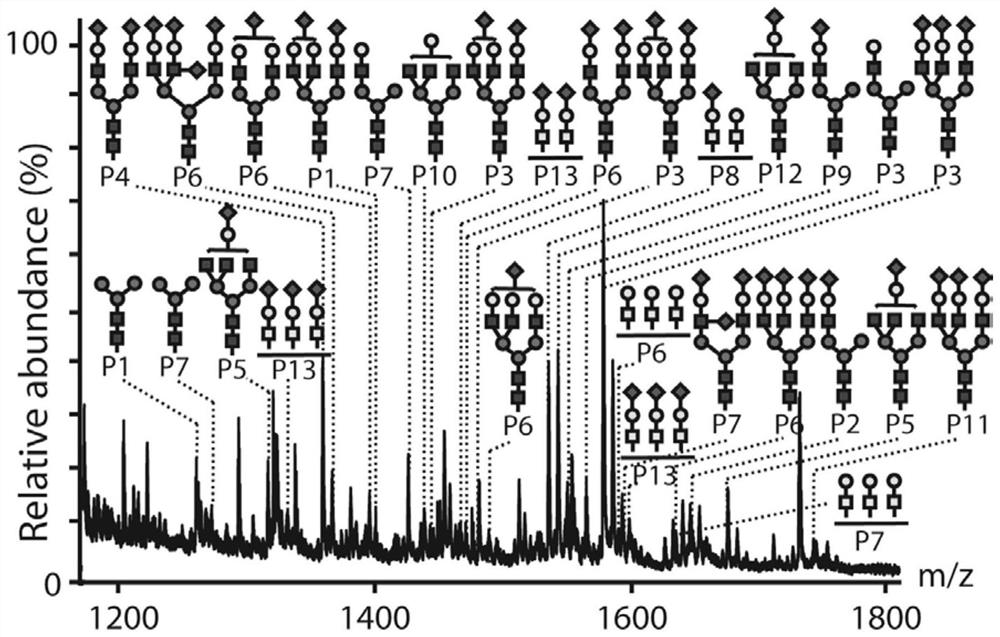A Glycopeptide Enrichment Method Based on Amphiphilic Porous Core-Shell Microspheres
A porous core and amphiphilic technology, applied in the field of medical testing, can solve the problems of low efficiency and achieve the effect of simple process and easy control of conditions
- Summary
- Abstract
- Description
- Claims
- Application Information
AI Technical Summary
Problems solved by technology
Method used
Image
Examples
Embodiment 1
[0033] Example 1 A method for enriching glycopeptides based on amphiphilic porous core-shell microspheres
[0034] A method for enriching glycopeptides based on amphiphilic porous core-shell microspheres, comprising the following steps:
[0035] 1) In the dSPE mode, put 50 μL of macroporous polydivinylbenzene-polyisopropylacrylamide core-shell microspheres (particle size 6 μm, average pore size 35 nm) into EP tubes, and wash them with 150 μL 20% acetonitrile / formic acid - Ammonium formate buffer solution (buffer salt concentration 5 mM, pH=4.8) and formic acid-ammonium formate buffer solution (buffer salt concentration 5 mM, pH=4.8) activation and equilibration. Dissolve the sample (10 μL desalted and spin-dried fetuin hydrolyzate (1 mg / mL) and 300 μg bovine serum albumin) in 1 mL formic acid-ammonium formate buffer solution (buffer salt concentration is 5 mM, pH=4.8), and equilibrate The final macroporous polydivinylbenzene-polyisopropylacrylamide core-shell microspheres wer...
Embodiment 2
[0037] Example 2 A method for enriching glycopeptides based on amphiphilic porous core-shell microspheres A method for enriching glycopeptides based on amphiphilic porous core-shell microspheres comprises the following steps:
[0038] 1) In the dSPE mode, put 30 μL macroporous polydivinylbenzene-polyisopropylacrylamide core-shell microspheres (particle size 10 μm, average pore size 20 nm) into EP tubes, and wash them with 150 μL 40% acetonitrile / acetic acid - Ammonium acetate buffer solution (20 mM buffer salt concentration, pH=6.0) and acetic acid-ammonium acetate buffer solution (20 mM buffer salt concentration, pH=6.0) activation and equilibration. Dissolve the sample (10 μL desalted spin-dried fetuin hydrolyzate (1 mg / mL) and 300 μg bovine serum albumin) in 1 mL acetic acid-ammonium acetate buffer solution (buffer salt concentration is 5 mM, pH=6.0), and equilibrate The final macroporous polydivinylbenzene-polyisopropylacrylamide core-shell microspheres were mixed evenly, ...
Embodiment 3
[0040] Example 3 A method for enriching glycopeptides based on amphiphilic porous core-shell microspheres
[0041] A method for enriching glycopeptides based on amphiphilic porous core-shell microspheres, comprising the following steps:
[0042] 1) In the dSPE mode, put 20 μL of macroporous polydivinylbenzene-polymethacrylamide core-shell microspheres (particle size 100 μm, average pore size 500 nm) into EP tubes, buffer with 2000 μL 50% acetonitrile ammonium carbonate solution (buffer salt concentration 20 mM, pH=8.1) and 3% acetonitrile / ammonium carbonate buffer solution (buffer salt concentration 20 mM, pH=8.1) to activate and equilibrate the material. Dissolve the sample (10 μL desalted and spin-dried fetuin hydrolyzate (1 mg / mL) and 300 μg bovine serum albumin) in 1.5 mL 3% acetonitrile / formic acid-ammonium formate buffer solution (buffer salt concentration is 5 mM, pH=4.8) Mix well with the equilibrated macroporous polydivinylbenzene-polyisopropylacrylamide core-shell m...
PUM
| Property | Measurement | Unit |
|---|---|---|
| diameter | aaaaa | aaaaa |
| pore size | aaaaa | aaaaa |
| pore size | aaaaa | aaaaa |
Abstract
Description
Claims
Application Information
 Login to View More
Login to View More - R&D
- Intellectual Property
- Life Sciences
- Materials
- Tech Scout
- Unparalleled Data Quality
- Higher Quality Content
- 60% Fewer Hallucinations
Browse by: Latest US Patents, China's latest patents, Technical Efficacy Thesaurus, Application Domain, Technology Topic, Popular Technical Reports.
© 2025 PatSnap. All rights reserved.Legal|Privacy policy|Modern Slavery Act Transparency Statement|Sitemap|About US| Contact US: help@patsnap.com


